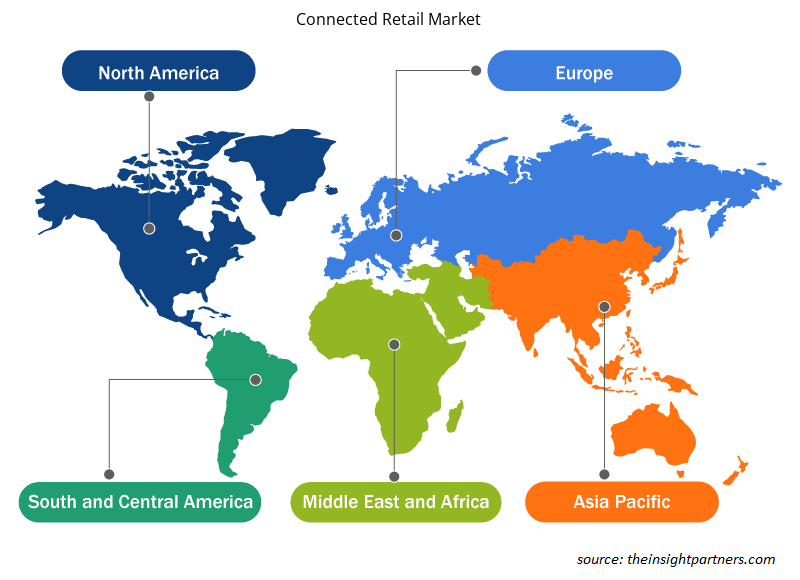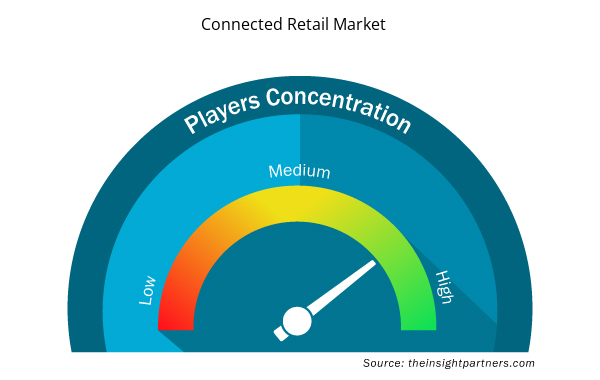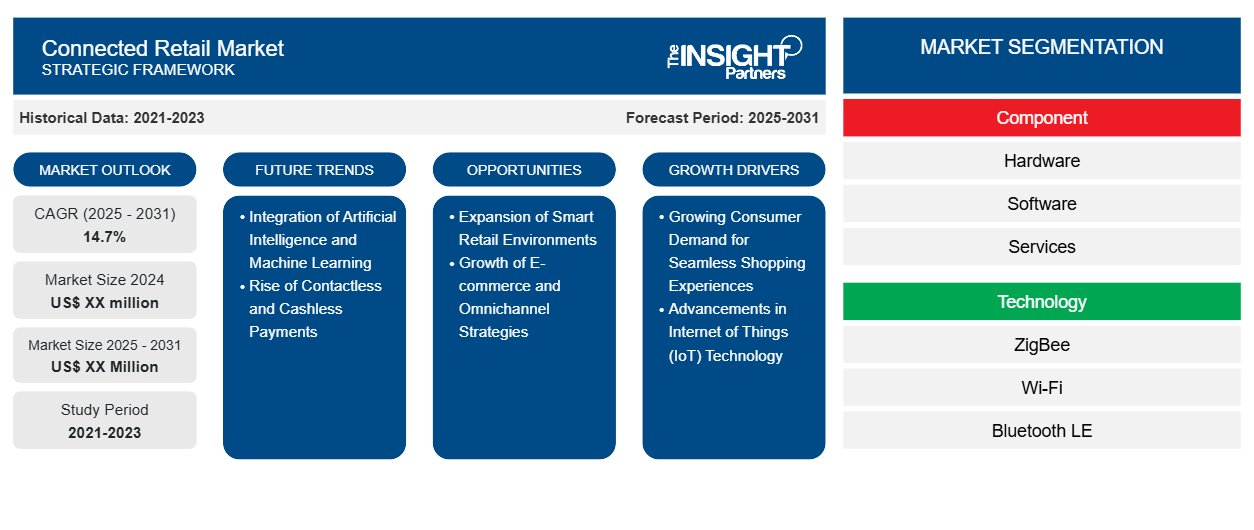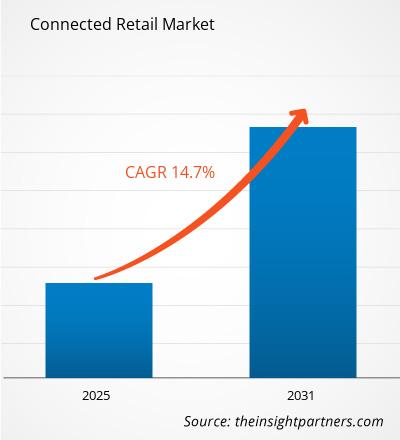Si prevede che il mercato del commercio al dettaglio connesso registrerà un CAGR del 14,7% dal 2024 al 2031, con una dimensione di mercato in espansione da XX milioni di dollari USA nel 2024 a XX milioni di dollari USA entro il 2031.
Il report è segmentato per Componente (Hardware, Software, Servizi); Tecnologia (ZigBee, Wi-Fi, Bluetooth LE, NFC, Altri). L'analisi globale è ulteriormente suddivisa a livello regionale e nei principali paesi. Il report offre il valore in USD per l'analisi e i segmenti di cui sopra.
Scopo del rapporto
Il report Connected Retail Market di The Insight Partners mira a descrivere il panorama attuale e la crescita futura, i principali fattori trainanti, le sfide e le opportunità. Ciò fornirà spunti a vari stakeholder aziendali, come:
- Fornitori/produttori di tecnologia: per comprendere le dinamiche di mercato in evoluzione e conoscere le potenziali opportunità di crescita, consentendo loro di prendere decisioni strategiche informate.
- Investitori: condurre un'analisi completa delle tendenze in merito al tasso di crescita del mercato, alle proiezioni finanziarie del mercato e alle opportunità esistenti lungo la catena del valore.
- Enti di regolamentazione: regolamentano le politiche e le attività di controllo sul mercato allo scopo di ridurre al minimo gli abusi, preservare la fiducia degli investitori e sostenere l'integrità e la stabilità del mercato.
Segmentazione del mercato al dettaglio connesso
Componente
- Hardware
- Software
- Servizi
Tecnologia
- ZigBee
- Wifi
- Bluetooth a bassa tensione
- Non-FC
- Altri
Personalizza questo report in base alle tue esigenze
Riceverai la personalizzazione gratuita di qualsiasi report, comprese parti di questo report, o analisi a livello nazionale, pacchetto dati Excel, oltre a usufruire di grandi offerte e sconti per start-up e università
- Scopri le principali tendenze di mercato in questo rapporto.Questo campione GRATUITO includerà analisi di dati che spaziano dalle tendenze di mercato alle stime e alle previsioni.
Driver di crescita del mercato del commercio al dettaglio connesso
- Crescente domanda dei consumatori per esperienze di acquisto senza soluzione di continuità: i consumatori si aspettano sempre di più un'esperienza di acquisto senza soluzione di continuità che unisca canali fisici e digitali. Le tecnologie di vendita al dettaglio connesse, come app mobili, beacon in-store e piattaforme omnicanale, soddisfano questa domanda consentendo percorsi di acquisto personalizzati e senza attriti. Dalla scoperta del prodotto all'acquisto e ai servizi post-acquisto, queste tecnologie migliorano la praticità e la soddisfazione del cliente, guidando la crescita del mercato della vendita al dettaglio connessa.
- Progressi nella tecnologia Internet of Things (IoT): la rapida adozione di dispositivi IoT negli ambienti di vendita al dettaglio è un fattore chiave per la vendita al dettaglio connessa. Sensori abilitati IoT, scaffali intelligenti e tag RFID consentono ai rivenditori di raccogliere dati in tempo reale su inventario, comportamento dei clienti e operazioni di negozio. Questi dati possono essere sfruttati per migliorare la gestione delle scorte, ottimizzare i layout dei negozi e offrire promozioni personalizzate, migliorando in definitiva l'esperienza del cliente e l'efficienza operativa, guidando l'espansione del mercato.
Tendenze future del mercato retail connesso
- Integrazione di intelligenza artificiale e apprendimento automatico: l'intelligenza artificiale e l'apprendimento automatico stanno diventando parte integrante del commercio al dettaglio connesso. Queste tecnologie consentono ai rivenditori di personalizzare le esperienze dei clienti, prevedere la domanda e ottimizzare la gestione dell'inventario. I chatbot e gli assistenti virtuali basati sull'intelligenza artificiale stanno migliorando il servizio clienti, mentre gli algoritmi di apprendimento automatico stanno potenziando le raccomandazioni sui prodotti. I rivenditori stanno investendo molto in queste tecnologie per fornire esperienze di acquisto più intelligenti e intuitive, il che sta alimentando la crescita nel settore del commercio al dettaglio connesso.
- Ascesa dei pagamenti contactless e cashless: il passaggio ai pagamenti contactless e cashless è una tendenza importante nel mercato del commercio al dettaglio connesso. Mentre i consumatori cercano modi più rapidi e sicuri per completare le transazioni, i rivenditori stanno adottando portafogli mobili, codici QR e tecnologie NFC. Queste soluzioni di pagamento non solo migliorano l'esperienza del cliente, ma forniscono anche dati preziosi ai rivenditori per comprendere meglio le preferenze e i comportamenti dei clienti, contribuendo alla continua crescita del commercio al dettaglio connesso.
Opportunità di mercato del commercio al dettaglio connesso
- Espansione degli ambienti di vendita al dettaglio intelligenti: l'integrazione di dispositivi e sensori intelligenti negli ambienti di vendita al dettaglio offre un'opportunità significativa per soluzioni di vendita al dettaglio connesse. Scaffali intelligenti, segnaletica digitale e sensori IoT possono migliorare le operazioni del negozio fornendo informazioni in tempo reale sull'inventario e sulle preferenze dei clienti. I rivenditori possono utilizzare questi dati per ottimizzare i loro layout, creare strategie di prezzo dinamiche e offrire esperienze personalizzate, guidando così vendite più elevate e soddisfazione del cliente.
- Crescita dell'e-commerce e delle strategie omnicanale: la continua crescita dell'e-commerce e la necessità di strategie omnicanale presentano notevoli opportunità per il commercio al dettaglio connesso. I rivenditori stanno integrando sempre di più le esperienze di acquisto online e offline, consentendo ai clienti di spostarsi senza problemi tra i canali. Le piattaforme di e-commerce e i negozi fisici stanno diventando interconnessi, offrendo ai clienti un'esperienza di acquisto unificata. Ciò crea opportunità di crescita per le tecnologie di vendita al dettaglio connesse che consentono visibilità dell'inventario, marketing personalizzato e servizio clienti coerente su tutti i canali.
Approfondimenti regionali sul mercato retail connesso
Le tendenze regionali e i fattori che influenzano il Connected Retail Market durante il periodo di previsione sono stati ampiamente spiegati dagli analisti di Insight Partners. Questa sezione discute anche i segmenti e la geografia del Connected Retail Market in Nord America, Europa, Asia Pacifico, Medio Oriente e Africa, e Sud e Centro America.

- Ottieni i dati specifici regionali per il mercato al dettaglio connesso
Ambito del rapporto sul mercato del commercio al dettaglio connesso
| Attributo del report | Dettagli |
|---|---|
| Dimensioni del mercato nel 2024 | XX milioni di dollari USA |
| Dimensioni del mercato entro il 2031 | XX milioni di dollari USA |
| CAGR globale (2024 - 2031) | 14,7% |
| Dati storici | 2021-2023 |
| Periodo di previsione | 2025-2031 |
| Segmenti coperti | Per componente
|
| Regioni e Paesi coperti | America del Nord
|
| Leader di mercato e profili aziendali chiave |
|
Densità degli attori del mercato retail connesso: comprendere il suo impatto sulle dinamiche aziendali
Il mercato del Connected Retail Market sta crescendo rapidamente, spinto dalla crescente domanda degli utenti finali dovuta a fattori quali l'evoluzione delle preferenze dei consumatori, i progressi tecnologici e una maggiore consapevolezza dei vantaggi del prodotto. Con l'aumento della domanda, le aziende stanno ampliando le loro offerte, innovando per soddisfare le esigenze dei consumatori e capitalizzando sulle tendenze emergenti, il che alimenta ulteriormente la crescita del mercato.
La densità degli operatori di mercato si riferisce alla distribuzione di aziende o società che operano in un particolare mercato o settore. Indica quanti concorrenti (operatori di mercato) sono presenti in un dato spazio di mercato in relazione alle sue dimensioni o al valore di mercato totale.
Le principali aziende che operano nel mercato del commercio al dettaglio connesso sono:
- Società Atmel
- Società per azioni ARM
- Cisco Systems, Inc.
- Società IBM
- Google, Inc.
Disclaimer : le aziende elencate sopra non sono classificate secondo un ordine particolare.

- Ottieni una panoramica dei principali attori del mercato Connected Retail
Punti di forza chiave
- Copertura completa: il rapporto esamina in modo esaustivo i prodotti, i servizi, le tipologie e gli utenti finali del mercato del commercio al dettaglio connesso, offrendo una panoramica olistica.
- Analisi degli esperti: il rapporto è compilato sulla base della conoscenza approfondita di esperti e analisti del settore.
- Informazioni aggiornate: il rapporto garantisce la pertinenza aziendale grazie alla copertura di informazioni recenti e tendenze nei dati.
- Opzioni di personalizzazione: questo report può essere personalizzato per soddisfare le esigenze specifiche del cliente e adattarsi in modo appropriato alle strategie aziendali.
Il rapporto di ricerca sul Connected Retail Market può, quindi, aiutare a guidare il percorso di decodificazione e comprensione dello scenario del settore e delle prospettive di crescita. Sebbene possano esserci alcune preoccupazioni valide, i vantaggi complessivi di questo rapporto tendono a superare gli svantaggi.
- Analisi storica (2 anni), anno base, previsione (7 anni) con CAGR
- Analisi PEST e SWOT
- Valore/volume delle dimensioni del mercato - Globale, regionale, nazionale
- Industria e panorama competitivo
- Set di dati Excel


- Environmental Consulting Service Market
- Trade Promotion Management Software Market
- Tortilla Market
- Automotive Fabric Market
- Precast Concrete Market
- Smart Grid Sensors Market
- Biopharmaceutical Tubing Market
- Drain Cleaning Equipment Market
- Excimer & Femtosecond Ophthalmic Lasers Market
- Vaginal Specula Market

Report Coverage
Revenue forecast, Company Analysis, Industry landscape, Growth factors, and Trends

Segment Covered
This text is related
to segments covered.

Regional Scope
North America, Europe, Asia Pacific, Middle East & Africa, South & Central America

Country Scope
This text is related
to country scope.
Domande frequenti
Some of the customization options available based on the request are an additional 3-5 company profiles and country-specific analysis of 3-5 countries of your choice. Customizations are to be requested/discussed before making final order confirmation# as our team would review the same and check the feasibility
The major factors driving the connected retail market are:
1. Increased Adoption of IoT and Smart Devices
2.Consumer Demand for Personalized Shopping Experiences
Key players in the connected retail market include Atmel Corporation, ARM Holdings PLC, Cisco Systems, Inc., IBM Corporation, Google, Inc., Intel Corporation, NXP Semiconductors NV., Microsoft Corporation, PTC, Inc., and Softweb Solutions, Inc
The Rise of Autonomous Retail and Checkout-Free Shopping is likely to remain a key trend in the market.
The Connected Retail Market is estimated to witness a CAGR of 14.7% from 2023 to 2031
Trends and growth analysis reports related to Technology, Media and Telecommunications : READ MORE..
1. Atmel Corporation
2. ARM Holdings PLC
3. Cisco Systems, Inc.
4. IBM Corporation
5. Google, Inc.
6. Intel Corporation
7. NXP Semiconductors N.V.
8. Microsoft Corporation
9. PTC, Inc.
10. Softweb Solutions, Inc
The Insight Partners performs research in 4 major stages: Data Collection & Secondary Research, Primary Research, Data Analysis and Data Triangulation & Final Review.
- Data Collection and Secondary Research:
As a market research and consulting firm operating from a decade, we have published and advised several client across the globe. First step for any study will start with an assessment of currently available data and insights from existing reports. Further, historical and current market information is collected from Investor Presentations, Annual Reports, SEC Filings, etc., and other information related to company’s performance and market positioning are gathered from Paid Databases (Factiva, Hoovers, and Reuters) and various other publications available in public domain.
Several associations trade associates, technical forums, institutes, societies and organization are accessed to gain technical as well as market related insights through their publications such as research papers, blogs and press releases related to the studies are referred to get cues about the market. Further, white papers, journals, magazines, and other news articles published in last 3 years are scrutinized and analyzed to understand the current market trends.
- Primary Research:
The primarily interview analysis comprise of data obtained from industry participants interview and answers to survey questions gathered by in-house primary team.
For primary research, interviews are conducted with industry experts/CEOs/Marketing Managers/VPs/Subject Matter Experts from both demand and supply side to get a 360-degree view of the market. The primary team conducts several interviews based on the complexity of the markets to understand the various market trends and dynamics which makes research more credible and precise.
A typical research interview fulfils the following functions:
- Provides first-hand information on the market size, market trends, growth trends, competitive landscape, and outlook
- Validates and strengthens in-house secondary research findings
- Develops the analysis team’s expertise and market understanding
Primary research involves email interactions and telephone interviews for each market, category, segment, and sub-segment across geographies. The participants who typically take part in such a process include, but are not limited to:
- Industry participants: VPs, business development managers, market intelligence managers and national sales managers
- Outside experts: Valuation experts, research analysts and key opinion leaders specializing in the electronics and semiconductor industry.
Below is the breakup of our primary respondents by company, designation, and region:

Once we receive the confirmation from primary research sources or primary respondents, we finalize the base year market estimation and forecast the data as per the macroeconomic and microeconomic factors assessed during data collection.
- Data Analysis:
Once data is validated through both secondary as well as primary respondents, we finalize the market estimations by hypothesis formulation and factor analysis at regional and country level.
- Macro-Economic Factor Analysis:
We analyse macroeconomic indicators such the gross domestic product (GDP), increase in the demand for goods and services across industries, technological advancement, regional economic growth, governmental policies, the influence of COVID-19, PEST analysis, and other aspects. This analysis aids in setting benchmarks for various nations/regions and approximating market splits. Additionally, the general trend of the aforementioned components aid in determining the market's development possibilities.
- Country Level Data:
Various factors that are especially aligned to the country are taken into account to determine the market size for a certain area and country, including the presence of vendors, such as headquarters and offices, the country's GDP, demand patterns, and industry growth. To comprehend the market dynamics for the nation, a number of growth variables, inhibitors, application areas, and current market trends are researched. The aforementioned elements aid in determining the country's overall market's growth potential.
- Company Profile:
The “Table of Contents” is formulated by listing and analyzing more than 25 - 30 companies operating in the market ecosystem across geographies. However, we profile only 10 companies as a standard practice in our syndicate reports. These 10 companies comprise leading, emerging, and regional players. Nonetheless, our analysis is not restricted to the 10 listed companies, we also analyze other companies present in the market to develop a holistic view and understand the prevailing trends. The “Company Profiles” section in the report covers key facts, business description, products & services, financial information, SWOT analysis, and key developments. The financial information presented is extracted from the annual reports and official documents of the publicly listed companies. Upon collecting the information for the sections of respective companies, we verify them via various primary sources and then compile the data in respective company profiles. The company level information helps us in deriving the base number as well as in forecasting the market size.
- Developing Base Number:
Aggregation of sales statistics (2020-2022) and macro-economic factor, and other secondary and primary research insights are utilized to arrive at base number and related market shares for 2022. The data gaps are identified in this step and relevant market data is analyzed, collected from paid primary interviews or databases. On finalizing the base year market size, forecasts are developed on the basis of macro-economic, industry and market growth factors and company level analysis.
- Data Triangulation and Final Review:
The market findings and base year market size calculations are validated from supply as well as demand side. Demand side validations are based on macro-economic factor analysis and benchmarks for respective regions and countries. In case of supply side validations, revenues of major companies are estimated (in case not available) based on industry benchmark, approximate number of employees, product portfolio, and primary interviews revenues are gathered. Further revenue from target product/service segment is assessed to avoid overshooting of market statistics. In case of heavy deviations between supply and demand side values, all thes steps are repeated to achieve synchronization.
We follow an iterative model, wherein we share our research findings with Subject Matter Experts (SME’s) and Key Opinion Leaders (KOLs) until consensus view of the market is not formulated – this model negates any drastic deviation in the opinions of experts. Only validated and universally acceptable research findings are quoted in our reports.
We have important check points that we use to validate our research findings – which we call – data triangulation, where we validate the information, we generate from secondary sources with primary interviews and then we re-validate with our internal data bases and Subject matter experts. This comprehensive model enables us to deliver high quality, reliable data in shortest possible time.


 Ottieni un campione gratuito per questo repot
Ottieni un campione gratuito per questo repot